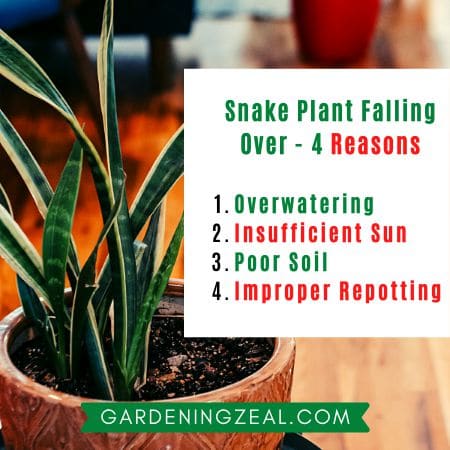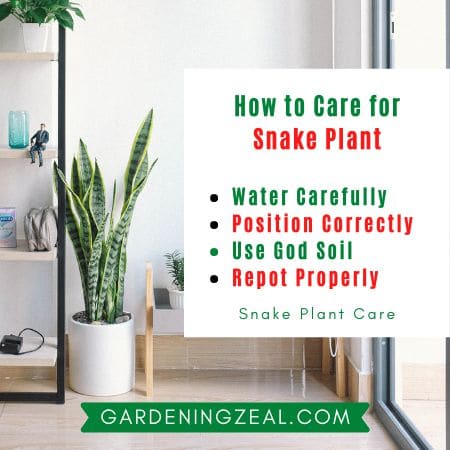Snake plants or Sansevierias are probably the easiest houseplants to look after, which is why many novice gardeners like to pick them as decoration. Still, snake plant falling over is the most serious problem that may result in no leaves on the plant, and it should be your first concern to find out why the leaves are falling.
Snake plant leaves fall over because of common reasons like overwatering, lack of sunlight, or unsuitable soil mix. Improper repotting also causes this problem as repotting make plant stressed out, due to which plant leaves become droopy and ultimately fall.
Thus, make sure to get into the details of all significant causes leading to snake plant leaves falling over and save your plant. Additionally, you will find counter solutions to keep plants erect and full of leaves.
Key Learning Points
What is Causing my Snake Plant Leaves to Fall?
Your snake plant is experiencing droopy leaves, and you don’t know why? You don’t have to worry too much because to help you figure it out, here are the most frequent mistakes snake plant owners make that you should definitely avoid!

- Overwatering
One thing people don’t know about Sansevierias is that they’re actually succulents. They store water in their leaves and thrive in dry environments; hence the most common mistake people make when caring for snake plants is overwatering them.
Overwatering a snake plant results in root rot, due to which the plant leaves appear to be droopy. The high water saturation in the soil makes it harder for the plant to breathe properly, making the roots thick and mushy.
Since Sansevierias are from the succulent family, they store water in their leaves, and with an overabundance of water in their leaves, they will become squishy, heavy, and yeah, you guessed it, droopy and limp.
The excess weight of the water will eventually make the snake plant completely fall over.
Insufficient Sunlight
Another reason that’s causing your snake plant leaves to fall is insufficient sunlight. Leaving your plant in a dark place for too long isn’t healthy.
Sansevierias don’t require direct sunlight and can survive with little sunlight; however, keeping them in a place with insufficient light for too long will dry your plant, and its leaves will start falling over.
Less sunlight may result in overwatering, especially if you don’t have a plant with drainage holes; because of that, the water cannot be evaporated, and the roots will absorb an excess of water resulting in root rot.
Poor Quality Soil
Using poor quality soil that does not have good drainage will also make your snake plant’s root rot. Poor drainage leads to the spread of a fungus that slowly kills the plant’s roots, due to which they can no longer support the leaves, and they begin to droop.

But how to tell if my soil is of poor quality or not? Don’t worry, to make sure your plant is getting the best soil blend, here’s a list of things you should avoid when choosing a soil mix for your snake plants.
- Soils that have a high saturation of clay. Clay is a dense material, and it retains water. That’s why if a large amount of clay is present in the soil, it won’t have good drainage resulting in a dying plant.
- You also need to avoid vermiculite. It’s a naturally occurring mineral and has small, brown flakes. It has properties similar to clay, it is very dense and retains moisture making it harmful for your snake plant.
- Avoid denser soil as aeration is really important for plants. Your soil should be able to transport gasses- like oxygen with ease. A good gas supply results in healthy roots.
Improper Repotting
If watering and sunlight aren’t the issues with your snake plant, it’s more likely happening because of improper repotting.
Repotting your plant as it grows is also a really crucial step for plant growth, which many people often overlook. The best time to repot your snake plants is during the winter or spring; however, if your plant has started to wither and has droopy leaves, you may need to repot it earlier than usual.
One of the biggest signs that you need to repot your snake plant is its roots spreading out from the bottom of the pot.
It indicates that your plant has outgrown its current pot and needs more room. Check if it’s stuck or loose. If it’s stuck, then you need to get a bigger pot for your plant.
Because of the insufficient space, none of the water was getting absorbed by the soil. That’s why it appeared to be lifeless.
How to Care For Your Snake Plant?
Now that you know what to avoid while dealing with snake plants taking care of them will be really easy. Mentioned below are correct ways you can look after your snake plant.
Watering Your Snake Plant Properly
Having a proper watering routine for the healthy growth of your plant is really important. You need to be very careful and attentive whilst watering your snake plant because overwatering can kill them.
You can test the soil with your fingers, and if the top 1.25 inches is dry, it’s time to water them. However, make sure to let the soil dry in between waterings; otherwise, you will end up overwatering.

When watering your snake plants, it’s best to water the soil directly. Soak the soil till all the water comes out of the drainage holes and if you’re using a pot without drainage holes, make sure you’re using less amount of water.
Do not spray the plant’s leaves using a spray bottle, as misting can cause moldy leaves.
Finding the Right Position
Snake plant leaves have the habit of leaning towards the side that has the most light; if your snake plant has been sitting in the same place for too long, some of its leaves will be droopy while the others erect.
That is why frequently rotating your snake plant to provide an equal amount of sunlight is something you can do to prevent snake plant leaves from falling over.
However, learning can also be a sign that your plant is not getting sufficient sunlight. In that case, you need to move your plant to a brighter place. Try avoiding places with direct sunlight to prevent your plant from drying out.
Using a Good Soil Blend
A good blend of soil is what makes your plant healthy and keeps it alive for a long time. Soil with proper drainage is crucial for a snake plant.
As we mentioned above, bad quality soil will lead to rotting roots. That is why having good quality soil for your plants is important, and for your assistance, here is a list of some of the best soil mixtures available in the market.
- Hoffman 10404 Organic Cactus and Succulent Soil Mix – contains organic ingredients, this mixture of soil provides good drainage and nutrition as well.
- Perfect Plants All Natural Succulent and Cactus Soil -affordable soil blend, perfect for indoor snake plants or other small succulents, also contains organic ingredients and provides good drainage.
- Superfly Bonsai Succulent & Cactus Soil Mix – it’s an all substrate formula, a great choice for outdoor succulents, a little expensive compared to others.
Repotting Your Snake Plant Correctly
If your snake plant leaves are falling even after repotting, then you probably made a mistake during the process.
You don’t need to panic because it’s actually really easy to repot your snake plant correctly. With the steps mentioned below, you will definitely master the skill of repotting!
- Start by selecting a new pot; you need to look for a wider pot that has a difference of about 2-3 inches from your old pot.
- Make sure the pot is sturdy and well balanced and won’t tip over because of your plant’s weight, as snake plants are on the bigger and heavier side.
- Remove the plant from its old pot and check for any root damage. If there are any mushy or dark spots, use a clean garden scissor to cut them off as they have rotted.
- Put the potting mix in the new pot and put your snake plant on top of it. Adjust the soil by adding or removing if necessary. Don’t need to tamp the soil. Just make sure it’s enough to support the plant, then water it. If it sinks below add a little bit more.
And that’s it! See, that wasn’t very difficult, was it?
Conclusion – Why is my Snake Plant Falling Over?
Snake plants are really easy to care for houseplants that make great decorations for indoors or outdoors; however, if you don’t pay attention to its needs, you will most likely end up with a withered plant with flopped leaves.
That is why we have mentioned everything you need to know about snake plants, from what causes their leaves to fall to what you can do to avoid it. With a little more knowledge and some tweaking, you will have a perfectly upright snake plant!
Leave a Reply